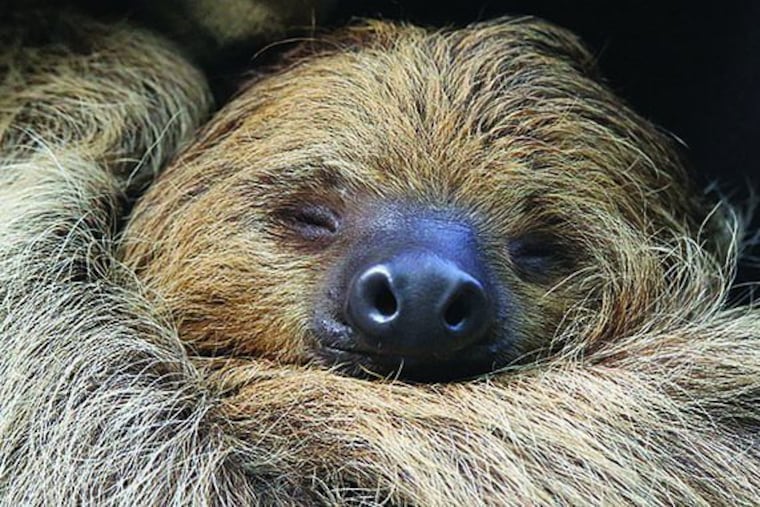Meet a live sloth, hedgehog, and more at the Academy of Natural Sciences’ ‘Survival of the Slowest’
Learn about some of the world's most sluggish (and adorable) animals...

A smiling two-toed sloth, a spiky African pygmy hedgehog, and a slithering ball python — you can see, and potentially touch, them all at the Academy of Natural Sciences’ new exhibit. Opening Feb. 15, Survival of the Slowest features 15 species of live animals. It also includes a full-time animal keeper who will take many of the animals out of their enclosures for an even closer, and sometimes hands-on, look.
“Kids won’t be petting the rattlesnake, but the ball pythons love to be held, and most of the other species will come out at times, too,” says Academy exhibition designer Lauren Duguid. “The sloth’s the clear winner. Based on its mood and if the audience is calm, the keeper will invite people to come up and gently touch it.”
Presented in both English and Spanish, the seven-month exhibit will explore how slow species evolved survival strategies to avoid being predators’ lunch.
“The exhibit flips evolution on its head,” says Duguid. “You think about species evolving to get bigger, faster, stronger, better, but that’s not always the way it goes. Being small and slow can have its advantages, too, and create more sophisticated ways of adapting.”
A good example, Duguid points out, is the algae that sloths grow on their fur. It helps to conceal sloths in the leafy forest canopies where they lounge high above ground.
“It’s like a little garden on their back — they look just like a branch,” says Duguid of the algae.
Sloths are also nocturnal, a characteristic that helps them avoid their main predator, the harpy eagle. For other strikingly slow animals, defense mechanisms include armor-like features, like the thick shell of a giant African land snail. One of the largest terrestrial gastropods, giant African land snails also eat both living and dead vegetation, which helps by minimizing the amount of energy they have to expend finding food.
“They’re unbelievable — the snails can get as big as a small-sized puppy, and they have these cute, bunny-rabbit-looking faces,” says Duguid.
Turning the Academy’s special exhibits gallery into a mini zoo, other live animals on display include a green iguana, green tree python, massasauga rattlesnake, fox snake, veiled chameleon, red-footed tortoise, Asian forest scorpion, giant African land snail, horned frog, chaco golden-knee tarantula, New Caledonian giant gecko, and a Dumeril’s monitor.
All of the animals will be shown in settings that mimic their natural habitats, from sandy desert-scapes to lush forests to tropical grasslands. There will also be an educational station about two species of sloths from the Ice Age: One once roamed around the Philadelphia region; the other, from the southern region of the United States, grew as large as an elephant. Visitors can view fossils from each, alongside modern two-toed sloth bones for comparison.
“Neither animal lived in trees like modern two- and three-toed sloths. They walked around on the ground like bears do,” says Duguid. “Humans were in North America during this time period, too, and scientists suspect they may have hunted ground sloths.”
The exhibit’s animal keeper will be available to field questions and feed the animals. There will also be a book corner for families to relax and a game station challenging visitors to move slower than a sloth. At a speed of six to eight feet per minute, it’s a surprisingly difficult task.
Survival of the Slowest is produced by Little Ray’s Nature Centres in Ottawa, in collaboration with the Canadian Museum of Nature. Little Ray’s is the largest exotic animal rescue organization in Canada, and most of the animals in the exhibit are rescues.
“It’s an animal exhibit where there’s not just photography or a couple of hands-on statues — there’s actual live animals that bring an opportunity for people to connect with nature in a strong way,” says the Academy’s head of public engagement Mary Bailey. “And it’s a good showcase of just how beautifully the world’s animals each fit into their environment.”
If you go: Feb. 15-Sept. 20, The Academy of Natural Sciences of Drexel University, 1900 Benjamin Franklin Pkwy, $18 and up, 215-299-1000, ansp.org